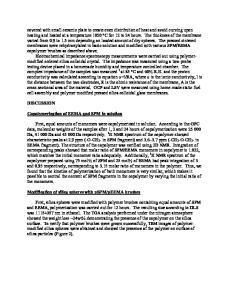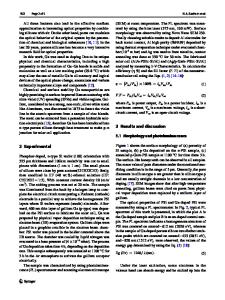Characterization and Fuel Cell Testing of Radiation-Grafted PSI Membranes
- PDF / 1,380,585 Bytes
- 13 Pages / 417.6 x 639 pts Page_size
- 24 Downloads / 297 Views
ABSTRACT We have demonstrated earlier the useful performance of our PSI radiation-grafted membranes in terms of the current-voltage characteristics of 30 cm 2 active area fuel cells containing these membranes and their long-term testing over 6,000 h at 60 'C. We report here on testing of PSI radiation-grafted membranes in these fuel cells at 80 'C and in short stacks comprised of two or four 100 cm2 active area cells. The in-situ degradation of membranes has been investigated by characterizing membranes both before testing in fuel cells and post-mortem after testing in fuel cells. Characterization was accomplished by means of ion-exchange capacity and infrared and Raman spectroscopic measurements. In addition, a rapid screening method for our ex-situ testing of the oxidative stability of proton-conducting membranes was developed in this work. Comparison of the initial screening test results concerning the oxidative stability of some perfluorinated, partially-fluorinated, and non-fluorinated membranes compare well qualitatively with the relative stability of these same membranes during their long-term testing in fuel cells. INTRODUCTION We demonstrated earlier [1] that the current-voltage characteristics of 30 cm2 active area fuel cells containing our PSI radiation-grafted membranes are comparable or better than those of these same cells containing Nafion membranes of about the same thickness and operating under the same test conditions (Nafion-impregnated E-TEK electrodes with a platinum loading of 0.8 mg cm 2 , 60 'C, H 2 and 02 at atmospheric pressure, XH2 = Xo 2 = 1.5). In addition, we reported [1] on long-term testing of these membranes for over 5,000 h at 60 'C in these same cells. The present investigation focuses on the testing of our PSI radiation-grafted membranes at a higher temperature of 80 'C in these same cells or at a temperature of 60 'C in short stacks comprised of two or four 100 cm2 active area cells. For example, we have recently developed [2] a portable PEFC power pack for educational purposes at universities and colleges. The bipolar and unipolar plates are made of graphite to minimize the weight of the power pack. The 10 cell stack from this power pack can supply a continuous power of 120 W at approximately 6 V and delivers a peak power of 300 W when operated on H2 and 02. After the initial development and testing of this stack using commercially available perfluorinated membranes, our goal has been to demonstrate our radiation-grafted membranes in these portable power pack stacks and their components. Therefore we are also beginning to scale up our process for the preparation of larger quantities of larger area membranes required for such power packs and even larger stacks. As discussed previously [1,3,4], larger active area fuel cells and their stacks can have somewhat different membrane requirements than smaller single cells due to the often greater and 259 Mat. Res. Soc. Symp. Proc. Vol. 575 ©2000 Materials Research Society
sometimes less homogeneous mechanical stresses involved in obta
Data Loading...











